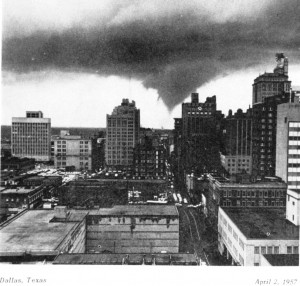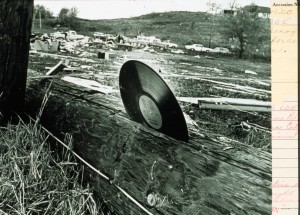Tornado Facts And Myths
FACT or MYTH? Tornadoes don’t hit big cities.
MYTH: There have been several large cities to fall victim to tornadoes. For example, tornadoes have hit Dallas, Texas; Miami, Florida; Oklahoma City, Oklahoma; Wichita Falls, Texas; Salt Lake City, Utah; and St. Louis, Missouri. As you can imagine by the picture shown below of a tornado approaching downtown Dallas, Texas on April 2, 1957, a tornado in a large city can be more destructive than one in a rural area as there is more debris that can be generated. Just imagine the debris from damaged buildings and the heavy concentration of automobiles in large cities.
MYTH: Tornadoes do occur in mountains. Tornadoes have been recorded in the high elevations of the Appalachians, Rockies and Sierra Nevada. Damage from an F3 tornado has been documented above 10,000 feet, and in the mountains of Utah, a hiker photographed a weak tornado. In 1987, an F4 tornado crossed the Continental Divide in Yellowstone National Park.
FACT or MYTH? Tornadoes do not go up and down steep or high hills.
MYTH: In 1974 in Guin, Alabama, a tornado stayed on the ground as it climbed the 1,640-foot high Monte Sano Mountain. It grew in intensity during its descent down the northeast slope. On the same day, The Blue Ridge tornado formed in the mountains at 1,800 feet, crossed a 3,000 foot ridge and then moved down to the bottom of the canyon. The tornado climbed to the 3,300 foot top of Rich Nob before finally dissipating.
FACT or MYTH? Tornadoes will not follow terrain into steep valleys or canyons.
MYTH: During the outbreak of tornadoes in 1974, three schools were wiped out in the town of Monticello, Indiana when the tornado, as it moved out of town, descended a 60 foot bluff over the Tippecanoe River damaging homes at its base. On August 11, 199, the Salt Lake City tornado crossed a canyon, descending on one side and rising up the other about halfway along its path.
FACT or MYTH? Cities protected by a river don’t get tornadoes
MYTH: Violent tornadoes have crossed rivers of all shapes and sizes. Almost every major river east of the Rockies has been crossed by a significant tornado.
There have been tornadoes that have crossed rivers and caused widespread damage to riverside cities. For example, the tornado that hit Natchez, Mississippi on May 7, 1840 formed a little before 1:o0 p.m. and then moved northeast along the Mississippi River, killing a total of 317 people, 269 of those were on the river on flatboats that sunk. The tornado then moved to the riverside port of Natchez Landing where there was almost complete destruction of dwellings, stores, steamboats and flatboat. Based on the damage it cause, t has been speculated that the tornado was the strength of an F5 tornado but there was no Fujita scale or other means of quantifying the strength in 1840.
Other examples of tornadoes crossing large rivers and devastating cities include St. Louis, Missouri and Waco, Texas. In 1896, a tornado jumped the Mississippi river during what has been named the Great St. Louis Cyclone of 1896 or the Great St. Louis Tornado. In 1953, a tornado crossed the Brazos River and struck Waco, Texas. So a river does not protect a city from tornadoes.
FACT or MYTH? A tornado will not touch down where two of major rivers flow together.
MYTH: In 1974, the town of Cairo, Ill., located at the confluence of the Ohio and Mississippi Rivers, was hit by a tornado.
FACT or MYTH? Tornadoes may occur in the middle of the night and even during the winter months.
FACT: Tornadoes have caused death and destruction during the night and winter, though the likelihood is lower at night and during colder months. While very unlikely during the winter months, violent tornadoes do occasionally occur at night.
FACT or MYTH? People and fragile items have been picked up by tornadoes, transported some distance and then found uninjured or undamaged.
FACT: Though it is true that people and animals have been transported a quarter mile or more without serious injury and fragile items, such as sets of fine china, or glass have been blown from houses and recovered, miles away, without any damage, these occurrences are rare given the quantity of airborne debris.
FACT or MYTH? A fast vehicle can outrun a tornado.
MYTH: Tornadoes are fast at up to 70 mph or more plus they can unpredictably and without warning shift directions. You do not want to try to outrace a tornado bearing down on you. It may be your last race. It is better to leave your vehicle and seek shelter.
FACT or MYTH? There can be an F6 tornado.
FACT: Even though tornadoes are typically categorized up to an F5, The Fujita Tornado Damage Intensity Scale actually goes up to an F12 level. The F12 level only begins at wind speeds exceeding Mach 1.0 or about 738 miles per hour at -3°C. Winds of an F5 tornado are up to 319 mph and are strong enough to completely destroy about everything in its path; therefore, an F6 tornado couldn’t do much more damage than an F5 so it could not be definitively labeled as more than an F5.
FACT or MYTH? Upon learning of a tornado warning, you should open all the windows in your house to equalize the pressure.
MYTH: A popular belief and one I heard recommended years ago, it is no longer recommended as this wastes precious time that you need to seek shelter and protection for yourself and your family.
FACT or MYTH? Mobile home parks seem to be like tornado magnets and are more likely to be hit by a tornado
MYTH: It just seems like mobile home parks are hit more often. In the U.S., there are many mobile home parks and there are tens of thousands of mobile homes in tornado alley so the probability, just by the sheer numbers, increases the likelihood that some of them will be in the path of a tornado. Unfortunately, because of their construction, mobile homes provide very little to no protection against even a weak tornado, so damage to a mobile home is more likely to be significant than the same tornado force that would hit a frame house. There is also the fact that many mobile home parks have a greater density of homes than many frame house so a mobile home park that is hit by a tornado, could hit more homes.
FACT or MYTH? Because of their sturdy and strong construction and material, brick or stone buildings will protect against a tornado.
MYTH: Even though brick and stone buildings will provide more protection than wood frame structures or mobile homes, tornado winds can easily drive a piece of 2×4 through even a brick wall. They can also cause wall or roof failure causing injury or worse.
FACT or MYTH? A tornado can drive straw through a telephone pole.
FACT: The forces inside a tornado are incredible, and are strong enough to turn harmless items into deadly projectiles and cause other bizarre occurrences. The photo below shows a innocuous LP record driven into a wood. I have heard of stories of pine straw being driven through telephone poles. Before we were married, a tornado hit my husband’s neighborhood. He had a window opened in the laundry room and straw from a pine tree was driven through the open window and driven into the ceiling of the laundry room.
In 1985, when a tornado hit our house in a different neighborhood, the workmen who were cleaning debris from the backyard, told me there was a dead bird in the backyard completely stripped of all of its feathers. It was definitely not something I wanted to go see.
FACT or MYTH? I am safe if a tornado is not coming directly towards me.
MYTH: Tornados can move erratically and change direction without warning possibly leaving you little to no time to get out of its path. Seek sturdy shelter immediately when a threat of a tornado is present. Leave tornado chasing to trained meteorologists. Chasing a tornado to get a photo may be the last photo you take.
FACT or MYTH? Tying oneself to a well pipe, like in the movie “Twister”, will prevent being sucked up into a tornado.
MYTH: Don’t you just love Hollywood’s interpretations! While the concept is partly correct inasmuch as a tornado will unlikely dislodge a deeply buried pipe, the problem comes with the execution. A rope tied around a person in this manner is more likely to act as a combination tetherball and cheese slicer. Unlike the movie where the actors were lifted upwards fairly gently (relatively speaking) while being tethered by ropes, in real life the lighter winds will likely cause you to be whipped around at the end of the rope and bang you against anything within the radius of the rope. Stronger winds inside the tornado could pull a body from the rope but not gently as in the movie. If you have ever seen the ferocity of a tornado, either in person, on TV or even the earlier parts of the “Twister” movie, you can imagine that the violent thrashing and turning within the confines of a rope could do serious damage to a body and this thrashing and turning could act as a cheese slicer to a body.

